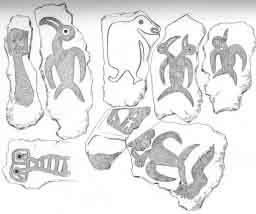
Sacred Texts Pacific Index Previous Next


Te Pito Te Henua, or Easter Island, by William J. Thompson, [1891], at sacred-texts.com
The most important sculptured rocks on this island (Plate XXII) are in the immediate vicinity of the stone houses at Orongo (Fig. 7). As

FIG. 7.
SCULPTURED ROCKS NEAR ORONGO
much time is possible was devoted to examining and sketching these curious relies. The hard volcanic rock is covered by carvings intended to represent human faces, birds, fishes, and mythical animals, all very much defaced by the ravages of time and the elements (Plate XXIII). The apparent age of some of the rock-carvings antedates the neighboring stone houses, the images, and other relics of the island except the ruined village on the bluff west of Kotatake Mountain. Fishes and turtles appear frequently among these sculptures, but the most common figure is a mythical animal, half human in form, with bowed back and long claw-like legs and arms. According to the natives. this symbol was
intended to represent the god "Meke Meke," the great spirit of the sea (Fig. 8). The general outline of this figure rudely carved upon the

FIG. 8.
SCULPTURED FIGURES OFTEN REPRODUCED ON ROCKS AT ORONGO: "MEKE MEKE"
rocks, bore a striking resemblance to the decoration on a piece of pottery which I once dug up in Peru, while making excavations among the graves of the Incas. The form is nearly identical, but, except in this instance, no similarity was discovered between the relies of Easter Island and the coast of South America.

PICTURED SLABS TAKEN FROM THE ANCIENT STONE-HOUSES AT ORONGO
(Cat No. 128373-128376, U. S. N. M. Easter Island. Collected by Commander B. F. Day, U. S. N.)